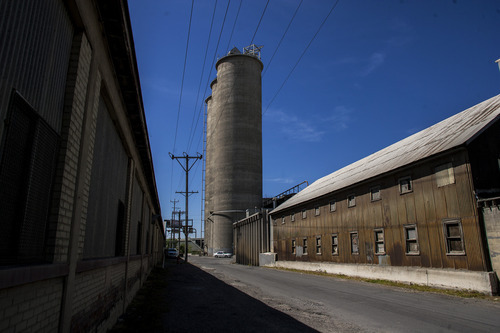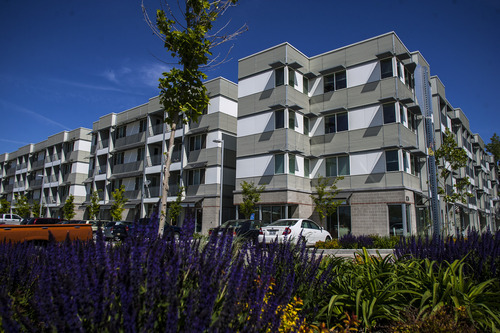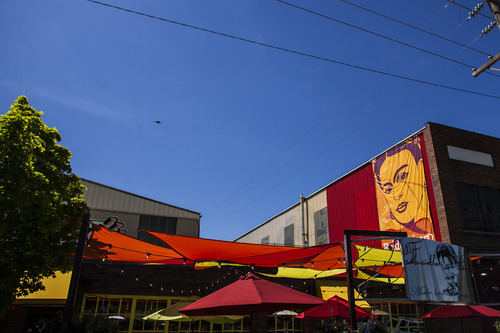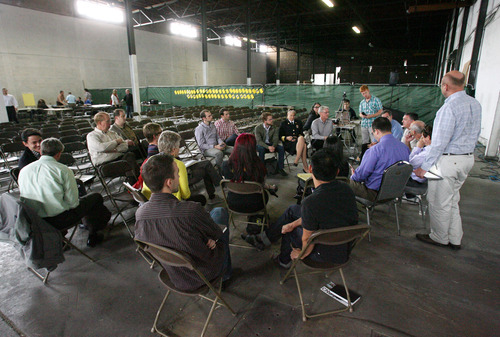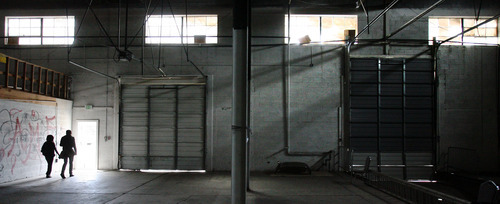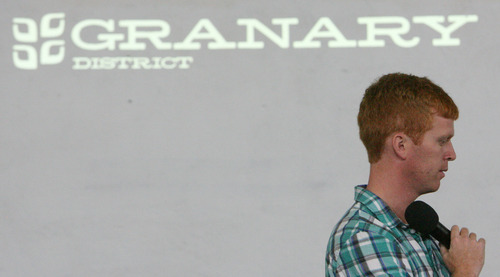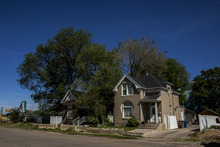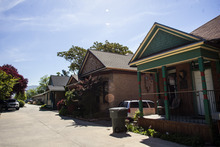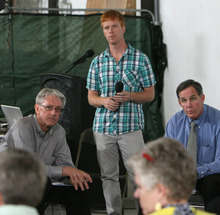This is an archived article that was published on sltrib.com in 2012, and information in the article may be outdated. It is provided only for personal research purposes and may not be reprinted.
An urban revolution has begun in Salt Lake City's Granary District.
About 150 residents and property owners in the light-industrial neighborhood — roughly bordered by 600 South, 300 West, the 900 South Interstate 15 off-ramp and I-15 — have been meeting for the past two years to grab control of the development of the industrial district that's only minutes by bike or TRAX train from downtown.
The series of public meetings is billed as "our neighborhood's best chance to shape its own future." But what sets apart these meetings is an emphasis on grass-roots control of growth by promoting individual ownership of small homesteads in a sustainable, walkable environment.
Fragmenting the district's blocks into a jigsaw puzzle of small lots isn't simply to make homeownership affordable to lower- and middle-income residents. It's also a strategy to thwart traditional large-scale development — the kind that creates the mixed-use "beige way" projects like The Gateway and City Creek — that often drive real-estate prices skyward.
"If [developers] want to go through the headache of dealing with 200 parcel owners and putting that together in a project — good luck," says James Alfandre of Kentlands Initiative, a nonprofit urban design group that works to promote "human-centered neighborhoods." Kentlands guided the Granary community through the seven days of meetings the group calls an urban-planning charrette.
"There's definitely an undercurrent of a guerrilla movement — but in a good way," Alfandre says of the Granary District's efforts to stave off gentrification.
"Development of [the Granary] should not be dictated to them by anyone," he says. "The residents will be in charge of their own destiny because, hopefully, they will own their own real estate."
—
Keeping it gritty • At the intense series of meetings, the Granary's community shared big ideas on how to stay small and funky. Its narrative for development is anchored in the words "gritty, diverse and grounded."
Such terminology is far away from the usual developer marketing-speak, but it reveals everything about the people who love the Granary, which is named for its earliest industries and is still dominated by warehouses, recycling yards, equipment yards and manufacturers.
The district has always had a small population of residents. But in recent years, the Granary also has become home to fine restaurants, such as Frida Bistro, and the home of many well-known artists, including Trent Call at Captain Captain Studios.
"The world 'gritty' was put forward by the people who live in the district," Alfandre explains. "Grit is different from dirt. Grit comes from productivity — it's not a bad thing. People who are attracted to this place are makers — woodworkers, some of the city's best artists and light industry. It's a haven for makers."
One such maker is Norm Feulner, owner of Bush Sales, which has sold electrical equipment in the district for 50 years. "I like it the way it is," Feulner says.
The business owner says increased population would mean increased theft and would make it difficult for large trucks to reach businesses. In addition, the city's plans for development would likely increase his taxes.
Alfandre and his planning group predict the Granary's population, which is 1,200 to 1,800 residents, would grow to 12,000 in 20 years as the Wasatch Front becomes more densely populated. Not everyone agrees on its direction, Alfandre says, but "growth is inevitable. But the crowd supported keeping the neighborhood the way it is and staying true to its history."
Residents' vision calls for an "industrial aesthetic" that would tuck cottages and apartments amid the silos, railroad sidings and equipment yards. Obviously, it's a vision that runs counter to the average real-estate agent's notion of "curb appeal."
Says Alfandre: "There was a big disconnect between what the city wanted to see down here and what the property owners' vision was for the neighborhood."
—
The establishment plan • In the late 1990s, the city laid out a plan for future development that likely would raze most of the existing industry to make way for a mix of retail, restaurants and residential — imagine a low-rise Gateway.
The timing of the charrette could not have been better. The city will be updating the zoning of the area next year and could make changes in regulations that could help, or hinder, the blooming of an industrial aesthetic.
Salt Lake City's Redevelopment Agency is interested in hearing the neighborhood's ideas, said Matt Dahl, senior project manager for the RDA, which contributed $23,800 to the Granary charrette.
But some of what emerged from the meetings is problematic, Dahl says, including keeping most of the industrial flavor. "One of the issues that we've had is with the description of 'gritty.' What does that mean? The grittiest side of the term — that would be a real challenge."
—
Designing for Gen Y • But Mike Watkins believes the community has a fighting chance for self-determination. "I've never been so optimistic about a neighborhood," says Watkins, a Washington, D.C.-based architect and urban designer who helped the group develop a "vision plan" during the charrette.
The Granary District's series of grass-roots-level design workshops anticipates the rise of Generation Y — roughly defined as Americans born since the late 1970s — along with a fundamental shift in lifestyle attitudes. Alfandre says 77 percent of the 80 million-strong Gen Y "want to live in the urban core."
"The American dream has changed," Watkins says. "We have to design for a generation that does not want to live in the suburbs."
"They don't like cars, and they use their expendable income for experiences and social activities," Alfandre told a crowd review of the design team's work. Evidence of the generational power shift was seen in the charrette itself, where much of the interaction and input came through social media, including Facebook, Twitter and Pinterest.
—
Industrial chic • At the beginning of the project, Watkins found one challenge to any human-scale development is Salt Lake City's huge 10-acre blocks — nine times the size of a Portland block.
But after a week of conversations, he came to believe the wide streets and deep blocks offer creative possibilities for innovative urban designers. Guided by the community's suggestions, the charrette's designers proposed that the blocks maintain an "industrial crust" of light industry, with cozy residential units in their core. The district's many courts and alleys could be developed into a "secret" web of bike trails and pedestrian networks that would link blocks socially.
"Inside the blocks, a collection of villages and small homes," Watkins said. "Affordable."
Salt Lake City's 130-foot-wide streets, among the widest streets plotted in America, offer even more possibilities, he said. Some lanes in the broad avenues could provide room for commuter bike routes and "bio-swaths." Some designers even suggested reducing traffic to a single lane and stacking small apartments, offices and boutiques in the space that remains. All the designs honored the residents' call for keeping the industrial grit.
"It will still be industrial with its semis and bikes," Watkins told a crowd review. "Look into saving the industrial elements. Keep the coolest materials in the ruins — stone and steel" to be rehabilitated as elements in gardens, climbing walls and parks.
"The challenge is to find tenants who are gritty, diverse and grounded," he said.
—
What now? • No one is sure about the next step in preserving the Granary's grit. But it's obvious that supporters of urban life and industrial chic need to commit to living in the district — soon. To retain the right mix of small-plot homeowners and small businesses, the neighborhood needs to develop incrementally.
Watkins suggests that the Granary group infuse at least one block with their ideas in time for the Congress for New Urbanism, an international organization promoting sustainable and "human-scaled" communities, that will be held in Salt Lake City next May.
"We need to pour fuel on the fire that's already here," Watkins told residents.
More about the Granary neighborhood
Follow the Granary's battle for self-determination on social media:
Facebook • http://www.facebook.com/granarydistrictslc
Twitter • @TheGranaryDist
Pinterest • This bulletin board offers the recommended urban aesthetic of the district : http://www.pinterest.com/hspung/granary-district-project
Website • granarydistrict.org
Salt Lake City's plan for the district • http://www.slcrda.com/projectsareas/WTG/ExSum.pdf
More • The Congress on New Urbanism will meet in Salt Lake City on May 29-June 1, 2013. http://www.cnu20.org.



